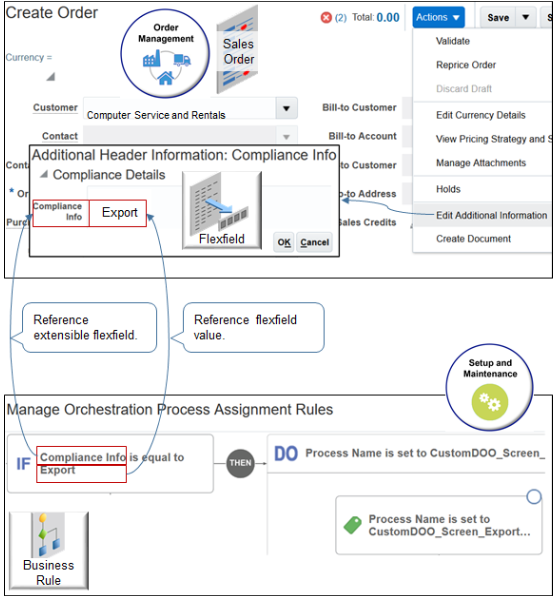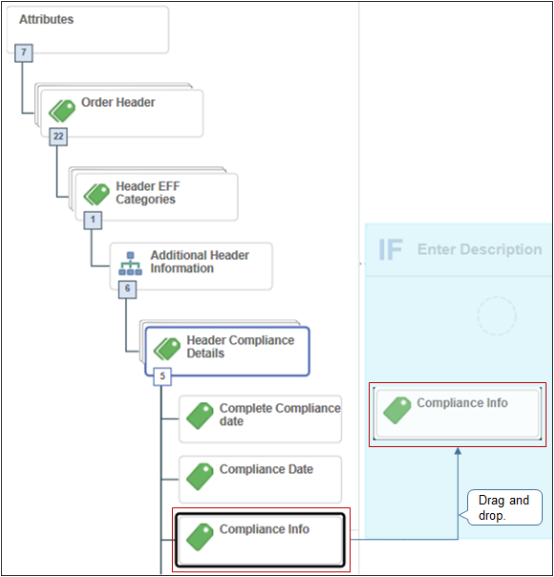Use Extensible Flexfields in Assignment Rules
Use an extensible flexfield to assign the fulfillment steps that your orchestration process does for each fulfillment line.
The fulfillment steps you use to fulfill an item might be different for each sales order depending on your business requirements.
An item attribute typically determines the orchestration process that runs and how to run orchestration process steps. If no predefined attributes meet your requirements, then you can create your own extensible flexfield, use it to capture important details about the item, then use it to select the fulfillment steps that run. You can write an assignment rule that uses extensible flexfield data as part of the selection criteria.
Assume.
-
You sell an item in your own country and to several other countries throughout the world.
-
The item includes details that are protected through international trade agreements.
-
If you ship the item to a location that's outside of your own country, then the trade agreements require you to consider it an export and screen it for trade compliance.
-
You do a needs analysis and determine to create the Trade Compliance Details extensible flexfield and add it to the order header so the Order Entry Specialist can enter the value Export to indicate whether the sales order is an export.
You will create an assignment rule that references the extensible flexfield.

You will create an assignment rule.
-
If the Trade Compliance Details extensible flexfield contains the value Export, then assign the fulfillment line to the Screen_Exports_for_Trade_Compliance orchestration process.
This topic uses example values. You might need different values, depending on your business requirements.
Assign an orchestration process according to the value of an extensible flexfield.
-
Set up the extensible flexfield and the orchestration process. Make sure you publish the extensible flexfield. If you don't publish, it won't show up the Manage Orchestration Process Assignment Rules page.
For details, see Overview of Using Extensible Flexfields in Order Management.
-
Create the assignment rule.
-
Go to the Setup and Maintenance work area, then go to the task.
-
Offering: Order Management
-
Functional Area: Orders
-
Task: Manage Process Assignment Rules for Sales Orders
-
-
On the Manage Orchestration Process Assignment Rules page, click Create New Rule.
-
Set the values.
Attribute
Value
Name
Assign for Trade Compliance
Description
Assign orchestration process depending on export.
-
-
Create the If statement.
-
Click in the If area to expand it.
-
On the Attributes tab, expand Order Header > Header EFF Categories > Additional Header Information > Header Compliance Details.
-
Click
Compliance Info, drag it, then drop it into the IF area.
-
In the Create Condition dialog, set the operator to
Is Equal To. -
Enter
Export, then click OK.
-
-
Create the Do statement.
-
Click Then > Do > New Action.
-
In the Create Action dialog, enter
process, wait a moment, then click Process Name (Order Fulfill Line).The phrase Order Fulfill Line indicates that the orchestration process you set will process order fulfillment lines.
-
-
Search for your orchestration process.
-
Click Search > Advanced.
-
Set Process Name to Contains.
-
Enter
Screen_Exports_for_Trade_Compliance.The search is case sensitive.
-
Click Search.
For this example, assume you already created and deployed this orchestration process. If you didn't deploy, then Search won't find it.
-
Click the row in the search results.
-
Click OK.
-
In the Create Action dialog, click OK.
-
-
Activate and publish your rule.